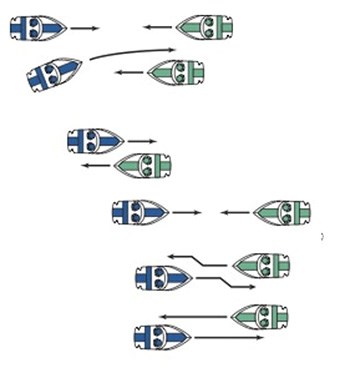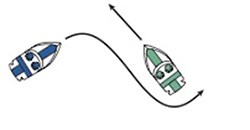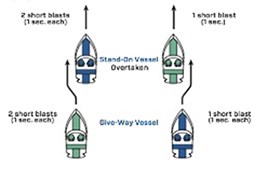STEERING RULES
Any time two (2) vessels on the water meet one another, one vessel has the right-of-way. It is called the stand-on vessel. The vessel that does not have the right-of-way is called the give-way or burdened vessel. These rules determine which vessel has the right of way, and accordingly, what each vessel should do.
The vessel with the right-of-way has the duty to continue its course and speed, except to avoid an immediate collision. When you maintain your direction and speed, the other vessel will be able to determine how best to avoid you.
The vessel that does not have the right of way has the duty to take positive and timely action to stay out of the way of the stand-on vessel. Normally, the give-way vessel should not cross in front of the stand-on vessel, but should slow down or change direction briefly and pass behind the other vessel. You should always move in such a way that the stand-on operator can see what you are doing if you are operating the give-way vessel.
GENERAL PRUDENTIAL RULE
This rule is called Rule 2 in the International Rules and says,In obeying and construing these rules due regard shall be had to all dangers of navigation and collision, and to any special circumstances, which may render a departure from the above rules necessary in order to avoid immediate danger.?
RULES WHEN ENCOUNTERING VESSELS
There are three (3) main situations in which you may encounter other vessels, and you must avoid a collision. These are:
-
Meeting (you are approaching another vessel head-on).
-
Crossing (you are traveling across the other vessel?s path).
-
Overtaking (you are passing or being passed by another vessel).
MEETING

If you are meeting another vessel head-on, and you are close enough to run the risk of collision, neither of you has the right-of-way. Both of you should alter course to avoid an accident. You should keep the other vessel on your port (left) side. (This rule doesn't apply if both of you can clear each other by continuing your set course and speed.)
CROSSING

OVERTAKING


